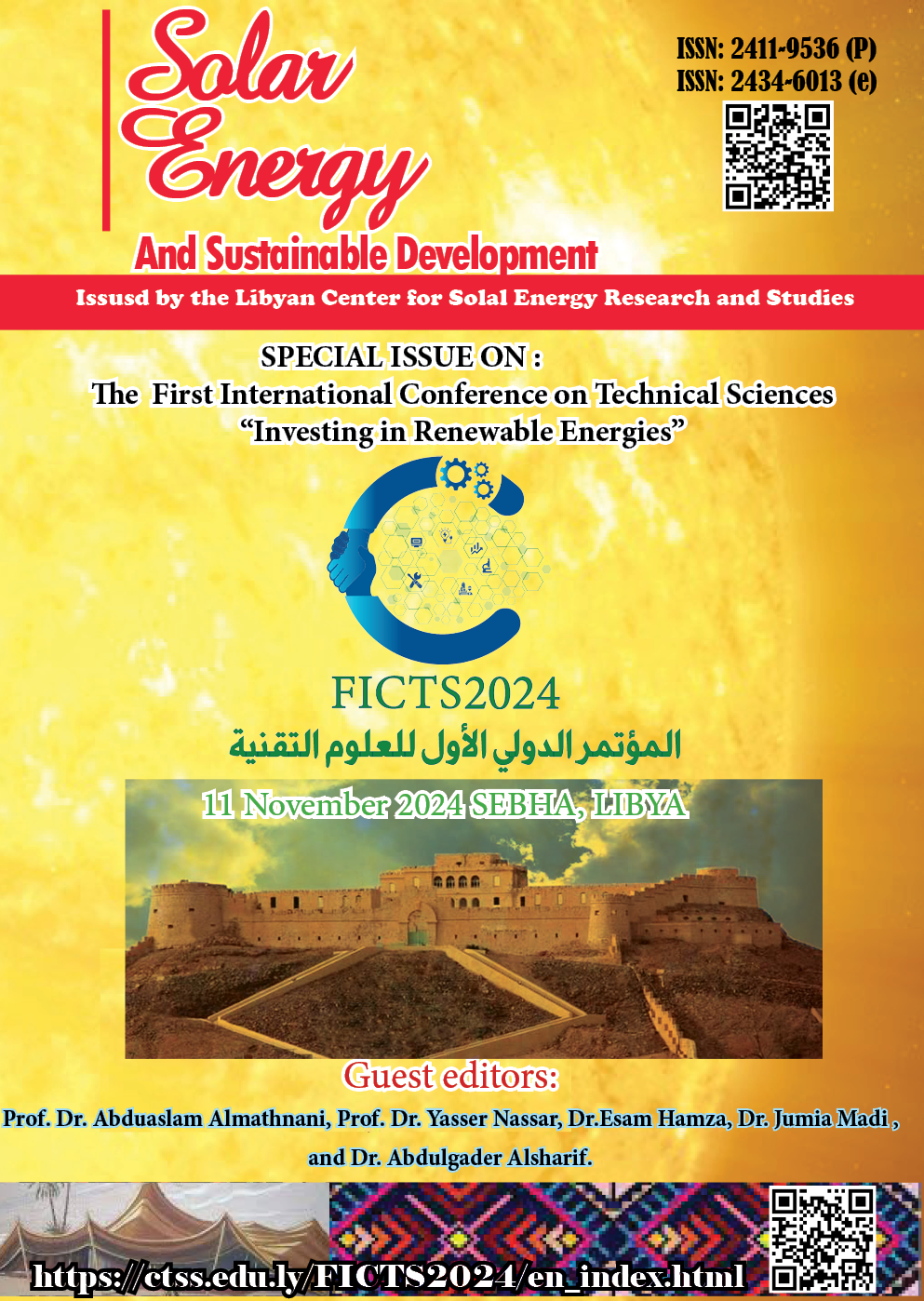Techno-Economic Analysis of Solar Energy Developing Technologies in Libyan Residential Communities
DOI:
https://doi.org/10.51646/jsesd.v14iFICTS-2024.447Keywords:
Solar Energy, Electrical Grid Network, Photovoltaic System (PV), HOMER Software, MATLAB Simulink SoftwareAbstract
These days, renewable energy is becoming increasingly vital. Renewable energy sources that are widely used include biomass, geothermal, wind, solar, and hydroelectric power. Because solar energy is sustainable, inexpensive to operate, and emits fewer greenhouse gases than fossil fuels, it has displaced them. The peak demand of Libya's inadequate public electrical network, which typically happens at midday, is one of the biggest issues. This problem is more prevalent in the summer, when heat waves, higher electrical loads (overload), and decreased energy plant efficiency cause voltage decreases. It is essential to address Libya's high radiation levels around midday in order to solve this issue. It can also be helpful to research and suggest ways to integrate solar energy systems in Libyan residential communities while designing and evaluating the techno-economic implications of doing so. This study assesses the techno-economic viability of the suggested solar system, design a plan for integrating solar energy into Libyan residential areas to support the electrical grid network, and maximize the installation of supported solar systems in residential communities. Both MATLAB/Simulink and HOMER were used in the simulation process. The obtained results demonstrated Libya's residential communities' successful incorporation of solar energy systems. Three electrical loads display net present value, and the work is important for analyzing the discount payback of the three loads. In contrast to low and medium load, big system high load completion is more practical in terms of a fast payback period and will result in a financial cost return in 6.2 years. Therefore, solar energy particularly photovoltaic energy has the potential to be a very practical solution for Libya's power interruptions and oscillations.
Downloads
Metrics
References
B. Igliński, M. B. Pietrzak, U. Kiełkowska, M. Skrzatek, G. Kumar, and G. Piechota, “The Assessment of Renewable Energy in Poland on the Background of the World Renewable Energy Sector” Energy, vol. 261, DOI: 10.1016/j.energy.2022.125319, 2022. DOI: https://doi.org/10.1016/j.energy.2022.125319
Sims, R., P. Mercado, W. Krewitt, G. Bhuyan, D. Flynn, H. Holttinen, G. Jannuzzi, S. Khennas, Y. Liu, M. O’Malley, L. J. Nilsson, J. Ogden, K. Ogimoto, H. Outhred, Ø. Ulleberg, F. van Hulle, “Integration of Renewable Energy into Present and Future Energy Systems”, In IPCC Special Report on Renewable Energy Sources and Climate Change Mitigation [O. Edenhofer, R. Pichs-Madruga, Y. Sokona, K. Seyboth, P. Matschoss, S. Kadner, T. Zwickel, P. Eickemeier, G. Hansen, S. Schlömer, C. von Stechow (eds)], Cambridge University Press, Cambridge, United Kingdom and New York, NY, USA, 2011.
Y. Sun, S. Li, B. Lin, X. Fu, M. Ramezani, and I. Jaithwa, “Artificial Neural Network for Control and Grid Integration of Residential Solar Photovoltaic Systems,” IEEE Trans. Sustain. Energy, vol. 8, no. 4, pp. 1484–1495, DOI: 10.1109/TSTE.2017.2691669, 2017. DOI: https://doi.org/10.1109/TSTE.2017.2691669
Pelland, S., and I. Abboud, “Comparing Photovoltaic Capacity Value Metrics: A Case Study for the City of Toronto, Progress in Photovoltaics,” 16(8), pp. 715-724, 2008. DOI: https://doi.org/10.1002/pip.864
Perez, R., M. Taylor, T. Hoff, and J.P. Ross, “Reaching Consensus in the Definition of Photovoltaics Capacity Credit in the USA: A Practical Application of Satellite-Derived Solar Resource Data,” IEEE Journal of Selected Topics in Applied Earth Observations and Remote Sensing, 1(1), pp. 28-33, 2008. DOI: https://doi.org/10.1109/JSTARS.2008.2004362
McNutt, P., J. Hambrick, M. Keesee, and D. Brown, “Impact of Solar Smart Subdivisions on SMUD’s Distribution System,” Technical Report NREL/TP-550-46093, National Renewable Energy Laboratory, Golden, CO, USA, 41 pp, 2009. DOI: https://doi.org/10.2172/962015
Achilles, S., S. Schramm, and J. Bebic, “Transmission System Performance Analysis for High-Penetration Photovoltaics, Subcontract Report,” National Renewable Energy Laboratory, Golden, CO, USA, 77 pp, 2008. DOI: https://doi.org/10.2172/924641
Q. Hassan, “Evaluation and Optimization of Off-Grid and On-Grid Photovoltaic Power System for Typical Household Electrification,” Renew. Energy, vol. 164, pp. 375–390, 2021, DOI: 10.1016/j.renene.2020.09.008, 2021. DOI: https://doi.org/10.1016/j.renene.2020.09.008
M. Chennaif, M. Maaouane, H. Zahboune, M. Elhafyani, and S. Zouggar, “Tri-Objective Techno-Economic Sizing Optimization of Off-Grid and On-Grid Renewable Energy Systems Using Electric System Cascade Extended Analysis and System Advisor Model,” Appl. Energy, vol. 305, p. 117844, 2022, DOI: 10.1016/j.apenergy.2021.117844, 2021. DOI: https://doi.org/10.1016/j.apenergy.2021.117844
B. C. Babu and S. Gurjar, “A Novel Simplified Two-Diode Model of Photovoltaic (PV) Module,” IEEE J. Photovoltaics, vol. 4, no. 4, pp. 1156–1161, DOI: 10.1109/JPHOTOV.2014.2316371, 2014. DOI: https://doi.org/10.1109/JPHOTOV.2014.2316371
P. V. Rosu, A. T. Plesca, G. Gabor, and G. Chiriac, “Optimizing the Operation of Photovoltaic Panel Systems,” EPE 2020 - Proc., 11th Int. Conf. Expo. Electr. Power Eng., no. Epe, pp. 318–321, DOI: 10.1109/EPE50722.2020.9305534, 2020. DOI: https://doi.org/10.1109/EPE50722.2020.9305534
A. Joseph and J. Kamala, “PV Array Characteristics Analysis Under Partial Shading & Modeling of P&O MPPT Applied Boost Convertor Using Matlab/Simulink,” Int. Conf. Energy Effic. Technol. Sustain. ICEETS, pp. 596–601, DOI: 10.1109/ICEETS.2013.6533452, 2013. DOI: https://doi.org/10.1109/ICEETS.2013.6533452
M. E. E. Telbany, A. Youssef, and A. A. Zekry, “Intelligent Techniques for MPPT Control in Photovoltaic Systems: A Comprehensive Review,” Proc., 4th Int. Conf. Artif. Intell. with Appl. Eng. Technol. ICAIET, pp. 17–22, 2015, DOI: 10.1109/ICAIET.2014.13, 2014. DOI: https://doi.org/10.1109/ICAIET.2014.13
A. Alsaif, Z. Miao, and L. Fan, “Inner Current Controls of Grid-Connected PV for Unbalanced Grid Conditions,” 2021 North Am. Power Symp. NAPS, no. 1, pp. 1–6, DOI: 10.1109/NAPS52732.2021.9654764, 2021. DOI: https://doi.org/10.1109/NAPS52732.2021.9654764
E. S. Pinto, L. M. Serra, and A. Lázaro, “Energy Communities Approach Applied to Optimize Polygeneration Systems in Residential Buildings: Case Study in Zaragoza, Spain,” Sustain. Cities Soc., vol. 82, no. March, p. 103885, DOI: 10.1016/j.scs.2022.103885, 2022.
K. V. Konneh et al., “Optimal Design and Performance Analysis of a Hybrid Off-Grid Renewable Power System Considering Different Component Scheduling, PV Modules, and Solar Tracking Systems,” IEEE Access, vol. 9, pp. 64393–64413, DOI: 10.1109/ACCESS.2021.3075732, 2021. DOI: https://doi.org/10.1109/ACCESS.2021.3075732
Pinto, L. M. Serra, and A. Lázaro, “Energy communities approach applied to optimize polygeneration systems in residential buildings: Case study in Zaragoza, Spain,” Sustain. Cities Soc., vol. 82, no. March, p. 103885, 2022, doi: 10.1016/j.scs.2022.103885. DOI: https://doi.org/10.1016/j.scs.2022.103885
A. Darshan et al., “Energy Audit of a Residential Building to Reduce Energy Cost and Carbon Footprint for Sustainable Development with Renewable Energy Sources,” Adv. Civ. Eng., vol. 2022, DOI: 10.1155/2022/4400874, 2022. DOI: https://doi.org/10.1155/2022/4400874
M. Narayanan, A. F. de Lima, A. F. O. de Azevedo Dantas, and W. Commerell, “Development of a coupled TRNSYS-MATLAB simulation framework for model predictive control of integrated electrical and thermal residential renewable energy system,” Energies, vol. 13, no. 21, pp. 1–29, 2020, doi: 10.3390/en13215761. DOI: https://doi.org/10.3390/en13215761
M. Padilha Campos Lopes, T. Nogueira, A. J. L. Santos, D. Castelo Branco, and H. Pouran, “Technical Potential of Floating Photovoltaic Systems on Artificial Water Bodies in Brazil,” Renew. Energy, vol. 181, pp. 1023–1033, DOI: 10.1016/j.renene.2021.09.104, 2022. DOI: https://doi.org/10.1016/j.renene.2021.09.104
M. N. Uddin, M. M. Biswas, and S. Nuruddin, “Techno-Economic Impacts of Floating PV Power Generation for Remote Coastal Regions,” Sustain. Energy Technol. Assessments, vol. 51, no. January 2021, p. 101930, DOI: 10.1016/j.seta.2021.101930, 2022. DOI: https://doi.org/10.1016/j.seta.2021.101930
Barakat, M. M. Samy, M. B. Eteiba, and W. I. Wahba, “Viability study of grid connected PV/Wind/Biomass hybrid energy system for a small village in Egypt,” 2016 18th Int. Middle-East Power Syst. Conf. MEPCON 2016 - Proc., pp. 46–51, 2017, doi: 10.1109/MEPCON.2016.7836870. DOI: https://doi.org/10.1109/MEPCON.2016.7836870
A. Alahmed, S. I. Sidiki, Y. Alharthi, G. M. Chaudhry, and M. K. Siddiki, “Design, Simulation and Financial Analysis of Stand-Alone Photovoltaic System at University of Missouri-Kansas City, Missouri, USA,” Conf. Rec. IEEE Photovolt. Spec. Conf., vol. 2016-Novem, pp. 3287–3291, DOI: 10.1109/PVSC.2016.7750273, 2016. DOI: https://doi.org/10.1109/PVSC.2016.7750273
A. Ghellab, T. E. Boukelia, N. Aderghal, and S. Djimli, PV / T Solar Collector Combined with a Heating/Cooling System for Domestic Use Under Algerian Climatic Conditions: a Case Study in Jijel,” UPB Sci. Bull. Ser. D Mech. Eng., vol. 84, no. 4, pp. 67–80, 2022.
C. Li et al., “Techno-Economic Feasibility Study of Autonomous Hybrid Wind/PV/Battery Power System for A Household in Urumqi, China,” Energy, vol. 55, pp. 263–272, DOI: 10.1016/j.energy.2013.03.084, 2013. DOI: https://doi.org/10.1016/j.energy.2013.03.084
Faisal A. Alfagi, “Feasibility of Solar Energy in Libya and Cost Trend, International Science and Technology Journal, vol. 03, pp. 1–16, 2022.
S. Makken, “A Comprehensive Economic Analysis of Solar and Wind Power and its Suitability to Libya,” The 1st International Conference on Renewable and Sustainable Energy, October 10-13, 2021 at Elbieda, Libya, 2022.
A. O. M. Maka, S. Salem, and M. Mehmood, “Solar Photovoltaic (PV) Applications in Libya: Challenges, Potential, Opportunities and Future Perspectives,” Clean. Eng. Technol., vol. 5, p. 100267, DOI: 10.1016/j.clet.2021.100267, 2021. DOI: https://doi.org/10.1016/j.clet.2021.100267
M. Almaktar, A. M. Elbreki, and M. Shaaban, “Revitalizing Operational Reliability of the Electrical Energy System in Libya: Feasibility Analysis of Solar Generation in Local Communities,” J. Clean. Prod., vol. 279, p. 123647, DOI: 10.1016/j.jclepro.2020.123647, 2021. DOI: https://doi.org/10.1016/j.jclepro.2020.123647
M. Almaktar, T. Hussein, A. Rahman, and A. M. Albreki, “Advantages of Utilizing the Solar Water Heating Technology in Reducing Total Electricity Consumption and Improving Grid Efficiency: A Case Study of Benghazi, Libya,” The 11th International Renewable Energy Congress (IREC 2020) at Tunisia. 2020. DOI: https://doi.org/10.1109/IREC48820.2020.9310393
M. I. Hammdan, “Systems in Saudi Arabia,” no. July, 2019, doi: 10.1007/s40998-019-00233-3. DOI: https://doi.org/10.1007/s40998-019-00233-3
Ahmed Odah, (2018): Performance Improvement of Solar PV Modules by Cooling System and the Economic Feasibility of applying it on large PV Power Plants, Master of Clean Energy and Energy Conservation Engineering, Faculty of Graduate Studies, An-Najah National University, Nablus, Palestine.
Y. Kassem, H. Çamur, and R. A. F. Aateg, “Exploring Solar and Wind Energy as a Power Generation Source for Solving the Electricity Crisis in Libya,” Energies, vol. 13, no. 14, DOI: 10.3390/en13143708, 2020. DOI: https://doi.org/10.3390/en13143708
S. Singh, M. Singh, and S. C. Kaushik, “Feasibility Study of an Islanded Microgrid in Rural Area Consisting of PV, Wind, Biomass and Battery Energy Storage System,” Energy Convers. Manag., vol. 128, pp. 178–190, DOI: 10.1016/j.enconman.2016.09.046, 2016. DOI: https://doi.org/10.1016/j.enconman.2016.09.046
Downloads
Published
How to Cite
Issue
Section
License
Copyright (c) 2025 Solar Energy and Sustainable Development Journal

This work is licensed under a Creative Commons Attribution-NonCommercial 4.0 International License.














